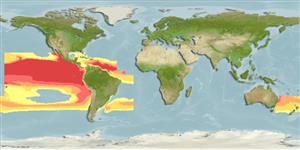>
Aulopiformes (Grinners) >
Scopelarchidae (Pearleyes)
Etymology: Scopelarchoides: Greek, skopelos = a lantern fish + Greek, archos = anus + Greek, oides = similar (Ref. 45335).
Environment: milieu / climate zone / depth range / distribution range
ນິເວດວິທະຍາ
ສັດທະເລ ກ່ຽວກັບ (ຢູ່) ຊັ້ນນ້ຳໃນທະເລເປີດທີ່ປອດແສງສ່ອງເຖິງ; ລະດັບຄວາມເລິກ 1 - 3294 m (Ref. 26340). Deep-water; 27°N -
Western Central Atlantic: Cuba (Ref. 26340). Eastern Pacific: Baja California, Mexico (about 27°N) to equatorial waters off Panama and Colombia (5°-9°N), and off Peru (about 6°-12°S) (Ref. 35929); also Chile (Ref. 9068).
ຂະໜາດ / ນ້ຳໜັກ / Age
Maturity: Lm ? range ? - ? cm
Max length : 10.5 cm SL ຕົວຜູ້/ບໍ່ມີເພດ; (Ref. 130965)
ຄີ (ໜາມ)ແຂງຢູ່ຫຼັງປາ (ທັງໝົດ) : 0; ຄີຫຼັງຂອງປາ (ຄີອ່ອນ) (ທັງໝົດ) : 6 - 7; ຄີ(ໜາມ) ແຂງຢູ່ຄີກົ້ນປາ
ກຸ່ມປາກະດູກແຂງ
ຄວາມຖີ່ຂອງກຸ່ມຖ່າຍທອດພັນ
ປາທີ່ມີການເຄື່ອນຍ້າຍຈາກທະເລໄປຫານ້ຳຈືດ ແລະນ້ຳຈືດຫາທະເລ
ປາທີ່ມີການເຄື່ອນຍ້າຍຈາກທະເລແລະໄປໄຂ່ຢູ່ນ້ຳຈືດ
ຄີກົ້ນຂອງປາ
ສັດທີ່ມີກະດູກສັນຫັຼງ
ການຖ່າຍທອດທາງກຳມະພັນຈາກພໍ່ແມ່ຫາລູກ: 0; ຄີກົ້ນຂອງປາ: 20 - 23; ສັດທີ່ມີກະດູກສັນຫຼັງ: 45 - 48. Branchiostegal rays: 8.
Occur in shallower part of depth range at night, deeper during the day (Ref. 35929). Oviparous, with planktonic larvae (Ref. 35929). Synchronous hermaphrodites (Ref. 35929).
Life cycle and mating behavior
Maturities | ການສືບພັນ | Spawnings | Egg(s) | Fecundities | ຕົວອ່ອນ
Claro, R., 1994. Características generales de la ictiofauna. p. 55-70. In R. Claro (ed.) Ecología de los peces marinos de Cuba. Instituto de Oceanología Academia de Ciencias de Cuba and Centro de Investigaciones de Quintana Roo. (Ref. 26340)
IUCN Red List Status (Ref. 130435)
Threat to humans
Harmless
Human uses
ເຄື່ອງມື
Special reports
Download XML
ແຫຼ່ງອີນເຕີເນັດ
Estimates based on models
Preferred temperature (Ref.
123201): 3.5 - 9.5, mean 5.2 °C (based on 238 cells).
Phylogenetic diversity index (Ref.
82804): PD
50 = 0.5313 [Uniqueness, from 0.5 = low to 2.0 = high].
Bayesian length-weight: a=0.01122 (0.00514 - 0.02450), b=3.04 (2.87 - 3.21), in cm total length, based on all LWR estimates for this body shape (Ref.
93245).
ຊັ້ນເຂດຮ້ອນ (Ref.
69278): 4.1 ±0.7 se; based on size and trophs of closest relatives
Fishing Vulnerability (Ref.
59153): Low vulnerability (10 of 100).
